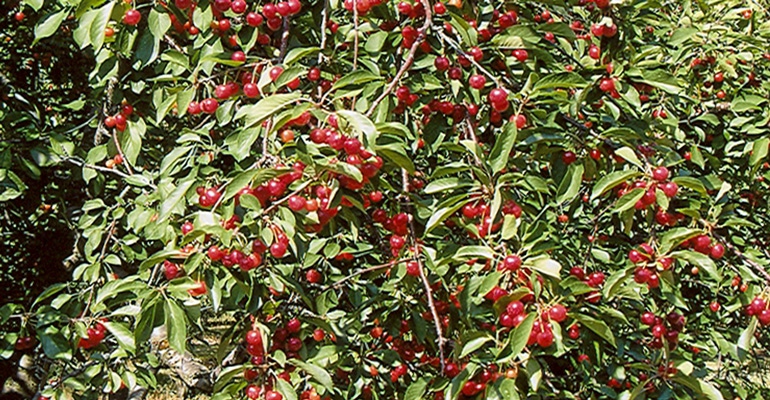
What exactly is the optimum supply of U.S. tart cherries to meet market demand? That was the question before the Cherry Industry Administrative Board (CIAB) when it convened June 27 for its annual preharvest forecast of poundage in each of the seven growing states.
The idea is to match the annual supply of domestic tart cherries with market demand to stabilize prices and provide a consistent supply to the market.
To do that, the national Cherry Marketing Order allows for a restriction — a portion of the crop to be kept off the free market. Growers wanted the order, because with so much of the nation’s supply grown in northwest Michigan, virtually the entire tart cherry crop can be devastated by one bad storm, or the market can be flooded in a good year.
It’s nothing new. The board has been doing this since the Cherry Marketing Order was re-established in 1997.
What is new in recent years is a bunch of new players in the game, importers, and one very big one — Turkey.
Determining a restriction
There was great contention about what the restriction should be among the 18-member CIAB, which consists of six producer members, eight handler members, three members who can be either producers or handlers, and one public member.
The Optimum Supply Formula is what the board uses to help calculate the restriction by considering such things as expected production for the year, a three-year sales average, carryover, market growth factors, economic adjustments, reserve inventory, targeted carryout and orchard diversion — meaning cherries either purposefully unharvested or destroyed on the farm. Many of the numbers plugged into the formula are at the board’s discretion.
Several members of the board took issue with including old inventory (mainly frozen) that is still on the free market in the formula. “That product is virtually unsalable,” said Dorance Amos, an Elk Township cherry and fruit grower. “That product was packed when Guthion (pesticide) was still legal to use, which it is not any more. Some of it goes back to 2014. It’s not illegal to sell it, but if I were a buyer, would I want old product or new product? This product should be destroyed before we make growers destroy fresh fruit.”
Dave Meister, a grower from Onekama, said the year and grade of stored cherries should be disclosed with only Grade A, cherries 3 years old or less, being considered as inventory and part of the formula in the future.
In debating the restriction, Don Gregory with Shoreline Fruit, a handler in Suttons Bay, said last year’s prices were some of the lowest ever.
“We need to restrict 65% so that growers still around next year may have a chance,” he said. “If we have no restriction, we’ll get rid of some (growers) this year, but anything in the middle is ensuring 10 cents (per pound) this year, and less next year.”
That brought about a motion for a 63% restriction, which was met with opposition from Tim Brian of Smeltzer Orchard, a handler based in Frankfort. “That will put fuel on the fire with imports,” he said.
Amos added, “You might as well kiss this tariff idea goodbye,” referring to the possibility that during the tariff investigation it may be construed as attempted price fixing.
Amos said some growers and handlers may be pushing for a higher restriction because banks have pulled back their funding mechanisms and plants cannot afford to run.
Another part of the equation is the recent availability of crop insurance covering 80% of fair market value for on-farm diversion fruit.
“All of this worries me when we go to fight this tariff battle, which we desperately need to win for the industry’s future,” Amos says. “We have to show injury by Turkey, not self-inflicted injury. If we don’t do something huge, like this tariff, our industry is dead, like a fish on shore. We need strong domestic competition for a vibrant industry. And we need a guy in the White House who has the ability to do it. The president really has a chance to make a difference for us.”
Jim Seaquist of Seaquist Orchards in Ellison Bay, Wis., and chairman of Cherrco (a five-state cooperative), said no restriction would be devastating to the growers. “We need a higher restriction and share the pain,” he said.
Ultimately, after long deliberations and votes that ranged from 63% to no restriction at all, the board decided on a 35% restriction, which is subject to change at the postharvest CIAB meeting Sept. 12.
That means, of the 248.2 million pounds of tart cherries U.S. farmers are predicting to produce (USDA’s June 1 forecast was at 290.2 million), almost 80 million pounds will need to be destroyed on the ground, diverted at the plant or put into storage to be used for only certain uses, which include establishing new markets, exports, displacement of imports and new products.
Processors dictate to growers how much of this year’s 35% should be diverted in-orchard and how much they may or may not pay for that fruit. They also set the price for delivered fruit.
It’s uncertain whether the tart cherry industry will continue to set a restriction. The Cherry Marketing Order, which expires every six years, is up for renewal in 2020.
Some help
While the tart cherry industry waits to hear the ruling on tariffs, it did get some good news that should help lower inventory. USDA recently announced it will buy an additional $15 million of U.S. tart cherries, which is in addition to the $15 million commitment from USDA in March.
It should be noted that USDA will only buy cherries less than 2 years old, so it will not affect older inventory. USDA says the purchases will be used to supply domestic food assistance programs, such as the National School Lunch Program.
About the Author(s)
You May Also Like






